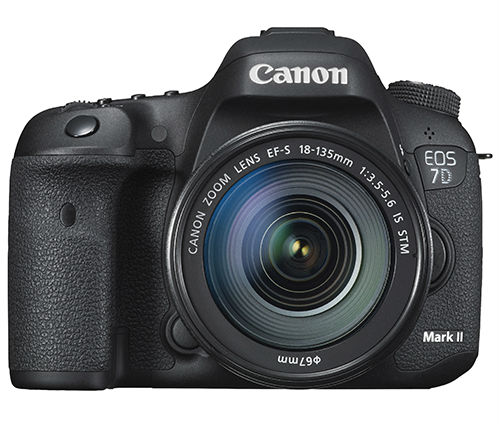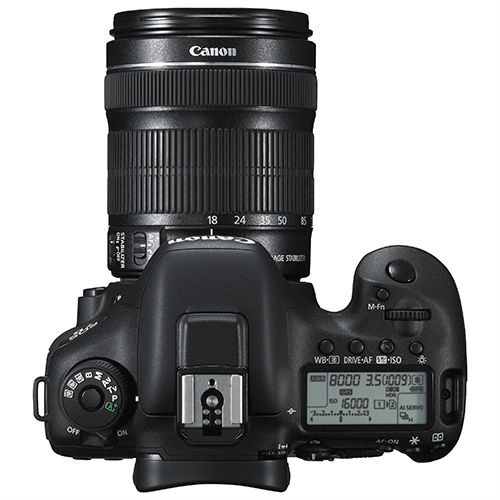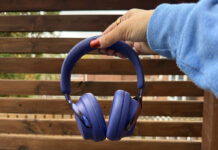 When my editor told me he had the Canon 7D MkII sitting on his desk, ready for review, he remarked that “this thing’s a beast!” I admit I was immediately intrigued. The 7D is Canon’s high-end consumer (as opposed to “pro”) DSLR, and carries a 20.2 megapixel APS-C CMOS sensor, and two Digic 6 image processors. The advantage of two image processors is that the 7D can get images onto the memory card very quickly. Because of this (and a new shutter mechanism) the 7D is capable of shooting a blazing 10 frames per second, and it can shoot about 130 jpegs consecutively, or 25 RAW images. We’re talking serious #burstmode!
When my editor told me he had the Canon 7D MkII sitting on his desk, ready for review, he remarked that “this thing’s a beast!” I admit I was immediately intrigued. The 7D is Canon’s high-end consumer (as opposed to “pro”) DSLR, and carries a 20.2 megapixel APS-C CMOS sensor, and two Digic 6 image processors. The advantage of two image processors is that the 7D can get images onto the memory card very quickly. Because of this (and a new shutter mechanism) the 7D is capable of shooting a blazing 10 frames per second, and it can shoot about 130 jpegs consecutively, or 25 RAW images. We’re talking serious #burstmode!
Durability
The 7D comes with a startling 65 cross-type (i.e. very accurate) auto-focus points. It has a range of different auto-focus modes to suit a variety of situations. The body is forged from magnesium which gives it enhanced durability without compromising weight or handling, and it has enhanced dust and weather resistance. The viewfinder is fantastic too, and boasts 100% coverage (so no more surprises at the edges of your images!) and 1.0x magnification.
Dual Card Slots
This is the first Canon DSLR (that I’ve used) that has dual card slots; it accepts a compact flash card and/or an SD card. You can choose which card to shoot to, or you can let the camera decide (it will fill one first, then the other). Or, you can use both simultaneously, meaning you get an instant backup of your images, in case one card should fail. Wedding photographers rejoice!
Attention To Detail
As a life-long Canon shooter, I can’t help comparing new models to those I’ve used before; often it’s the little things that catch my eye. For example, when you open the cover to access the memory card on my 5D MkII, it flops around on the hinges loosely. With the 7D however, it’s spring-loaded, so it remains fully open until you’re ready to close it. It’s little details like this that show that Canon put a lot of thought into the 7D.
Mode Lock
Another feature I wish I had on my 5D is the mode lock feature. Sometimes when I’m shooting I suddenly notice my settings are gone awry; my shutter speed is way too low, or my aperture too high and my exposure is way off. The reason is that I’ve accidentally moved the mode dial (usually from aperture priority mode to manual mode). There’s a little button on top of the mode dial on the 7D which you need to depress in order to rotate the dial itself. It’s a bit like a confirmation pop-up on a computer—”Are you sure you want to do that?”
Smooth And Quiet
The very moment I shot my first frame with the 7D I was aware of that new shutter mechanism—it’s very smooth and quiet. As someone who likes to photograph people as unobtrusively as possible, this is very appealing to me. And if you really want to get stealthy, you can switch to silent mode, a feature which anyone who likes to shoot candids and documentary is bound to love.
But when I switched to continuous mode I have to say I was just blown away by that 10 frame per second rate—this thing just hums as it captures those frames! I photographed my wife tobogganing with our son, and it was so quick there was barely any difference between each photo. What also impressed me though was the tracking focus. The camera was able to maintain perfect focus between shots.
Overwhelming Menu
On the downside, I have to say I didn’t love the menu setup at all. It’s really bloated with options and I found it very cumbersome to navigate. I really would have expected Canon to do better in this area. I’m surprised at how often manufacturers release cameras with below par user experiences. It seems that every device is getting easier to use—except my camera! Maybe this is a result of trying to get more and more features in there, but the fact is that each user will only ever use a subset of those features, depending on what they shoot. Personally I’d like to be able to fully customize my options.
Custom Buttons
Speaking of customization, I definitely did like the fact that I was able to customize the functionality of an array of buttons and dials. As I said before, every photographer has their preferences depending on their style and subject, so it’s great to be able to get the most commonly used controls right at your fingertips. Oddly though you are limited in which controls you can add to which dial or button, which is a little unfortunate.
Electronic Level
There are a couple more great features that I want to mention. The 7D comes with an electronic level which lets you know when the camera is tilted off-axis. It’s actually very fluid and performs really nicely. You also get built-in GPS which attaches Geotag information to each image, giving you longitude, latitude and elevation, a fantastic feature to have when you’re travelling or scouting locations. A feature I sorely miss though is Wi-Fi. Maybe Canon feels that enthusiasts don’t care about sharing images, but I think this is a significant omission. On the plus side, you can post-process your images right there on the camera, which is something I love to do in transit or while taking a break from shooting.
The Canon 7D is definitely a professional grade camera in terms of build quality and functionality, but as a professional photographer, the fact that it doesn’t have a full-frame sensor is a major drawback for me. I need that full-frame sensor to know that I have the ability to make big prints, and also for the superior high-ISO performance that a bigger sensor provides. I have no doubt, however, that the 7D will gain plenty of fans, and I expect to see lots of enthusiasts toting theirs around beautiful Vancouver.




